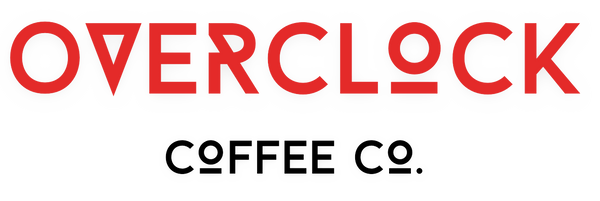
The Ultimate Coffee Bean Guide: Types, Freshness & Brewing Mastery
The Ultimate Coffee Bean Guide: Types, Benefits, and How to Choose
When people search for the perfect cup, it all begins with the bean. Whether you're a casual sipper or an Overclock Guild member powering up for the day, understanding your coffee beans helps you brew smarter, tastier, and fresher.
Types of Coffee Beans (and Why They Matter)
There are four main types of coffee beans in the world:
| Coffee Bean | Taste Profile | Caffeine | Origin Regions | Price |
|---|---|---|---|---|
| Arabica | Smooth, mild, nuanced | Medium | Latin America, Africa | Higher |
| Robusta | Bitter, strong, earthy | High | Southeast Asia, Africa | Lower |
| Liberica | Woody, floral, bold | Medium | Philippines, Malaysia | Moderate |
| Excelsa | Tart, fruity, complex | Medium | Southeast Asia | Moderate |
Arabica accounts for about 60–70% of the world's coffee production (International Coffee Organization, 2023). It’s also the bean of choice for Overclock Coffee’s flavored lineup.
Arabica vs. Robusta: The Classic Debate
Arabica beans are considered premium due to their balanced flavor and lower bitterness. They grow at higher elevations, require cooler climates, and contain more lipids and sugars than Robusta, giving them their signature taste (Farah, 2012).
Robusta, on the other hand, is prized for its higher caffeine content and durability. It’s often used in espresso blends for added crema and punch.
“Robusta contains nearly twice the caffeine content of Arabica, which contributes to its stronger taste and stimulant effect.” (Clifford & Willson, 1985)
How Roast Level Affects Bean Flavor
| Roast Level | Characteristics | Best For |
| Light | Bright, acidic, retains origin flavor | Pour over, single-origin fans |
| Medium | Balanced, sweet, versatile | Drip coffee, cold brew |
| Dark | Bold, smoky, low acidity | Espresso, French press |
Overclock Coffee roasts its beans in small batches to preserve flavor complexity and freshness. Each roast is designed for a specific use case whether it’s our time-warping French Toast Capacitor or the bold Dragon’s Breath.
Health Benefits of Coffee Beans
Beyond flavor, coffee beans pack health perks:
- Antioxidants: Coffee is the #1 source of antioxidants in the American diet (Powers & Jackson, 2018).
- Brain Boosting: Caffeine improves memory, mood, and energy (McLellan, Caldwell, & Lieberman, 2016).
- Metabolism Support: Coffee consumption can enhance fat oxidation and endurance (Acheson et al., 1980).
Choosing the Best Beans for You
When shopping for the ultimate coffee bean, consider:
- Flavor profile (Do you prefer nutty, chocolatey, fruity?)
- Caffeine level (High for hustle or low for chill?)
- Brew method (Espresso? Drip? Cold brew?)
- And of course freshness matters most. That’s where Overclock comes in.
Overclock Picks: Geek-Tested Coffee Beans
| Blend | Bean Type | Roast | Notes |
| Zombie Espresso Antidote | Arabica | Dark | Earthy, bold, nutty |
| French Toast Capacitor | Arabica | Medium | Maple, cinnamon, vanilla |
| Expedition Colombia | Arabica | Medium | Cherry, brown sugar, clean finish |
These aren’t just good beans; they’re story-driven, adventure-ready brews engineered for flavor.
Final Brewdown
Choosing the best coffee bean is more than just preference, it’s personal power. Whether you're coding at 2AM or leveling up your taste buds, knowledge is the ultimate ingredient.
With Overclock’s small-batch, story-rich, and flavor forward beans, you’re always brewing with the best.
References
Acheson, K. J., Gremaud, G., Meirim, I., Montigon, F., Krebs, Y., Fay, L. B., ... & Tappy, L. (2004). Metabolic effects of caffeine in humans: lipid oxidation or futile cycling? The American journal of clinical nutrition, 79(1), 40-46. https://doi.org/10.1093/ajcn/79.1.40
Clifford, M. N., & Willson, K. C. (1985). Coffee: Botany, Biochemistry and Production of Beans and Beverage. Springer. https://link.springer.com/book/10.1007/978-94-009-4855-1
Farah, A. (2012). Coffee Constituents. John Wiley & Sons. https://www.wiley.com/en-us/Coffee+Constituents-p-9781118296408
International Coffee Organization. (2023). Coffee Market Report. https://www.ico.org/Market-Report-23.asp
McLellan, T. M., Caldwell, J. A., & Lieberman, H. R. (2016). A review of caffeine’s effects on cognitive, physical and occupational performance. Neuroscience & Biobehavioral Reviews, 71, 294–312. https://doi.org/10.1016/j.neubiorev.2016.09.001
Powers, S. K., & Jackson, M. J. (2018). Exercise-induced oxidative stress: cellular mechanisms and impact on muscle force production. Physiological Reviews, 88(4), 1243–1276. https://doi.org/10.1152/physrev.00031.2007
